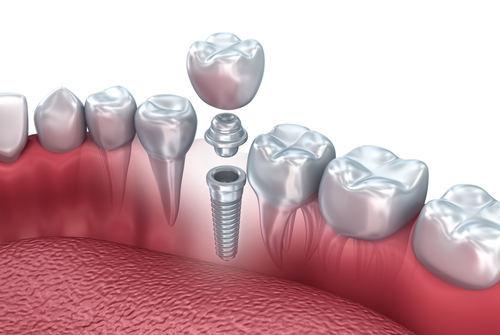$25 Off: New Patients
Save $25 on your first PDM visit.
DOWNLOAD COUPONDespite improvements in access to oral care, many Americans still suffer tooth loss. According to the National Institute of Dental and Craniofacial Research, adults aged 20 to 64 have an average of 24.92 teeth. If you exclude wisdom teeth, this means that the average adult has lost approximately 4 teeth!
For many years, the only treatments available for people with missing teeth were bridges and dentures. Now, with the rise of dental implants, more people than ever benefit from tooth replacement. Dental implants are replacement roots that provide a fixed foundation for artificial teeth. This article explains why people lose their teeth, how implants can help, and the types of dental implants available now.
Tooth loss can occur suddenly or over a period of many years. In many cases, losing teeth can be prevented through regular dental visits and preventive treatments. Most annual dental visits include radiography (an x-ray) that shows incipient cavities. In-office fluoride application and other preventive measures are effective treatments for dental caries. An untreated cavity can progress into deep-seated decay that will penetrate the inner chambers of the teeth. When this occurs, you face a greater risk of losing the tooth altogether.
But cavities aren’t the primary way that people lose teeth. Contrary to popular belief, gum disease is the leading cause of tooth loss. If you have experienced gum bleeding and sensitivity, than you may have first-stage gum disease, mild gingivitis. The most advanced stage, known as periodontitis, indicates the presence of infection in the gum tissues. Gum disease often leads to tooth loss as a result of gum recession, which gradually erodes support for the teeth.
Broken teeth are another cause, whether from an accident, chewing on hard foods, or grinding at night. A broken tooth may be minor at first but it requires treatment to prevent the break from extending deep into the tooth’s root. At that point, a root canal procedure may be used to try to save the tooth. Extraction is the last resort, becoming necessary only when infection threatens the surrounding area, or when the tissues around a fractured root become inflamed. Once the tooth has been extracted, the next step to protect your oral health is to replace the missing tooth.
 The term “implant” refers to the fact that the base of your replacement tooth is surgically grounded in the jaw. Implantation is a highly successful procedure and a healthy one as well! Choosing dental implants is the best decision you can make because this replacement option will naturally stimulate bone growth in the jaw, similar to what occurs with your natural teeth!
The term “implant” refers to the fact that the base of your replacement tooth is surgically grounded in the jaw. Implantation is a highly successful procedure and a healthy one as well! Choosing dental implants is the best decision you can make because this replacement option will naturally stimulate bone growth in the jaw, similar to what occurs with your natural teeth!
There are two major types of implants:
When the jawbone does not provide sufficient support for an endosteal implant, several techniques can be used to rebuild the bone and restore the jawline. The following procedures are options for patients who wish to receive an implant even though they have bone loss:
No matter what type of dental implant you’re considering, you’ll want expert care to ensure a successful dental implant procedure. The student dentists at Penn Dental Medicine are overseen by the best in the industry, giving you the opportunity to receive elite care at discounted prices. To schedule your FREE prosthodontics consultation at PDM, please call 215-898-8965 or fill out our appointment form today.
Get Your Appointment Now
We look forward to serving you and your family.